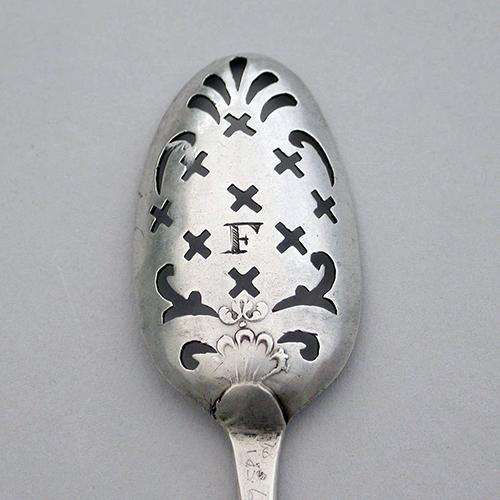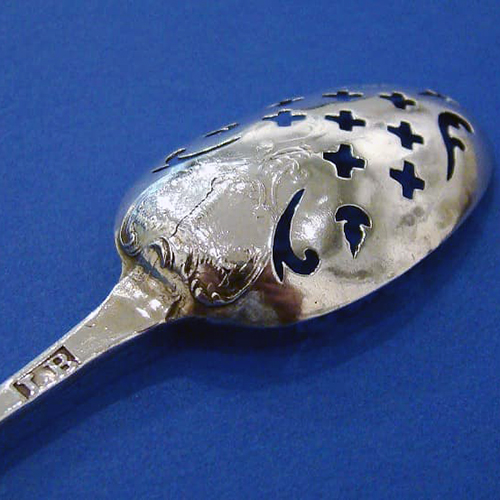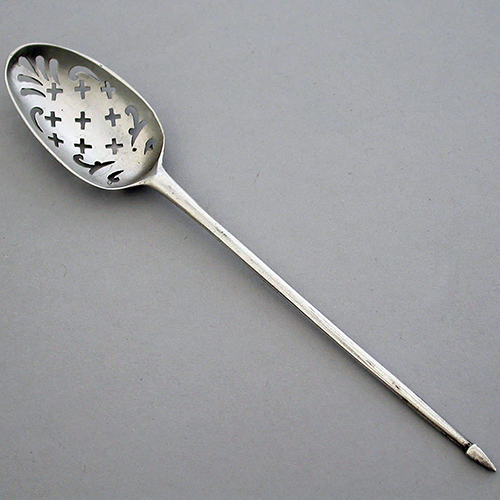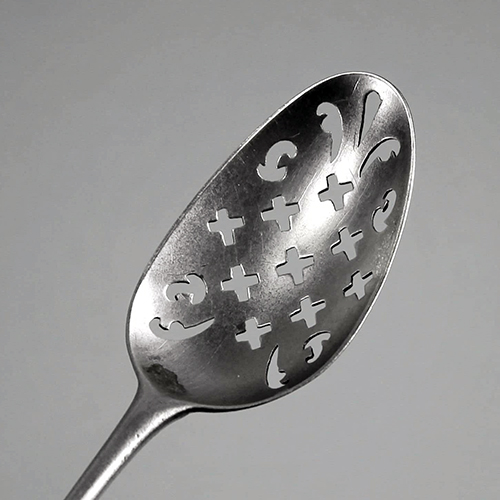

BADA member David Buck of Steppes Hill Farm Antiques explores the history of the Mote Spoon.
The tiniest mote of dust, or a tiny piece of a substance; a speck, is how the Oxford English Dictionary describes the Old English word 'mote'. Despite its high price and desirability, tea would still have been imported and sold in a relatively crude state in the late 17th and early 18th centuries, containing plenty of dust and large tea leaves or motes.
So it was that the silver mote spoon, or mote skimmer as they were originally described, became an important part of the fashionable tea equipage of the period. The exact use to which they were put is still debated but it seems likely that the pierced bowl would facilitate the removal of some of the dust when lifting the tea from the Caddy to the Pot. It is thought that they would also be utilised for removing excess floating leaves and debris from the cup or bowl once the tea had been poured.
In addition, the pointed terminal was used to clear blockages from the grill inside the teapot, and not as some authors would have it; for clearing the curved spout from the front. The spoon could also be used to simply stir the tea within the pot; it was a multi-functional item!
 Mote Spoons were produced for a relatively short span of years from approximately 1695 through to the 1780s. Their forms of construction, style and decoration mirror perfectly the changing fashions and designs of the period.
Mote Spoons were produced for a relatively short span of years from approximately 1695 through to the 1780s. Their forms of construction, style and decoration mirror perfectly the changing fashions and designs of the period.
The Mote Spoon evolved in many ways over its short life span. During the late 17th century, the mote spoon had a very simple pierced bowl with plain holes and the long thin stem forming the handle was of a uniform thickness. The stem and bowl were made of two pieces, being attached with a soldered "rat-tail". They were usually marked on the bowl. These early 17th century pieces are very rare.
During the early 18th century Queen Anne and George I period the bowl remained quite simple, however, a pierced scroll pattern rather than just plain holes starts to appear. The piercing tends to be fairly well spaced out and 'reserved' with no 'crosslets'. At this time, the bowl and stem are made from one piece of silver. The back of the bowl still has a "rat-tail" and the stem starts to taper to a simple point with no 'barb' or finial. The marks are now on the stem and would include the maker's mark, perhaps twice, or the maker's mark and the lion passant or Britannia standard marks.
 The bulk of Mote Spoons were produced during the George II and early George III period. A shorter "rat tail", drop or double drop, are now found on the back of the bowl. The "Fancy Back" or "Picture Back" similar to contemporary Teaspoons of the period also appear at this time and a shell heel is often found.
The bulk of Mote Spoons were produced during the George II and early George III period. A shorter "rat tail", drop or double drop, are now found on the back of the bowl. The "Fancy Back" or "Picture Back" similar to contemporary Teaspoons of the period also appear at this time and a shell heel is often found.
The bowls now show more elaborate pierced designs of rococo scroll work, circles, slats, pales, fleur-de-lys, mushrooms, serifs, and in particular 'crosslets' which really characterised the intricately pierced mid 18th century silver Mote Spoon.
Further diversions included the addition of engraving to the design. Particularly fine cast Rococo examples are rare and especially sought after. The marks during this period are on the stem and again include the maker's mark struck one or two times (a duty dodger) or the maker's mark struck once and the lion passant struck once. Due to the small circumference of the tapered handles the marks are often poorly struck or "pinched" and quite often indecipherable.
The vast majority of silver Mote Spoons were made in England, and indeed virtually all of those were assayed in London. Scottish and Irish examples are extremely rare and just a few were made in America.
Mote Spoons have become quite sought after and collectable and the price of an 18th century silver Mote Spoon compared to a contemporary silver teaspoon of similar construction and design can be 20 to 30 times higher, so it is perhaps not surprising that fake examples are sometimes found.
 These are generally converted Teaspoons with reshaped handles and later pierced bowls. One should take note of the length of the spoon and the shape of the bowl as well as the quality of the piercing. Mote Spoons tend (although not always) to be longer than Teaspoons and the bowl shape is generally more elongated and narrower.
These are generally converted Teaspoons with reshaped handles and later pierced bowls. One should take note of the length of the spoon and the shape of the bowl as well as the quality of the piercing. Mote Spoons tend (although not always) to be longer than Teaspoons and the bowl shape is generally more elongated and narrower.
Mote Spoons rarely exhibit noticeable wear or thinning to the sides of the bowl as might be the case with an adapted Teaspoon. The distinctive and intricate piercing of the bowls with crosslets and other symbols was a highly skilled and time-consuming task to perform and might not be repeated by an impatient fraudster (simple drilled holes were not usually found after about 1735).
Length can be a good guide to determine the authenticity of a silver Mote Spoon, but it should be pointed out that genuine mid-18th century miniature or "toy" examples are known as well as huge or extra-long handled versions probably for use in a Tea Urn.
Click here to view a selection of mote spoons currently available from BADA members.

